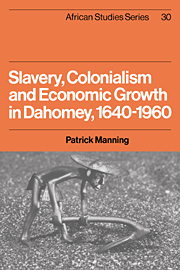Book contents
- Frontmatter
- Contents
- Maps
- Tables
- Figures
- Preface
- 1 Slavery, colonialism and economic growth, 1640–1960
- 2 The Dahomean economy, 1640–1890
- 3 Struggles with the gods: economic life in the 1880s
- 4 Production, 1890–1914
- 5 Demand, 1890–1914
- 6 Exchange, 1890–1914
- 7 The alien state, 1890–1914
- 8 Social struggles for economic ends, 1890–1914
- 9 The mechanism of accumulation
- 10 Capitalism and colonialism, 1915–60
- 11 The Dahomean national movement
- 12 Epilogue
- Notes
- Appendix 1 Export revenue from Dahomey, 1640s–1950s
- Appendix 2 Slave exports by ethnic origin
- Appendix 3 Population loss due to slave exports
- Appendix 4 Foreign trade of Dahomey
- Appendix 5 Foreign trade indices
- Appendix 6 Rainfall
- Appendix 7 Fiscal flows
- Appendix 8 Money supply of colonial Dahomey
- Bibliography
- Index
1 - Slavery, colonialism and economic growth, 1640–1960
Published online by Cambridge University Press: 26 October 2009
- Frontmatter
- Contents
- Maps
- Tables
- Figures
- Preface
- 1 Slavery, colonialism and economic growth, 1640–1960
- 2 The Dahomean economy, 1640–1890
- 3 Struggles with the gods: economic life in the 1880s
- 4 Production, 1890–1914
- 5 Demand, 1890–1914
- 6 Exchange, 1890–1914
- 7 The alien state, 1890–1914
- 8 Social struggles for economic ends, 1890–1914
- 9 The mechanism of accumulation
- 10 Capitalism and colonialism, 1915–60
- 11 The Dahomean national movement
- 12 Epilogue
- Notes
- Appendix 1 Export revenue from Dahomey, 1640s–1950s
- Appendix 2 Slave exports by ethnic origin
- Appendix 3 Population loss due to slave exports
- Appendix 4 Foreign trade of Dahomey
- Appendix 5 Foreign trade indices
- Appendix 6 Rainfall
- Appendix 7 Fiscal flows
- Appendix 8 Money supply of colonial Dahomey
- Bibliography
- Index
Summary
The Bight of Benin came to the attention of the wider world in the late seventeenth century as it became the leading supplier of slaves for the plantations of the New World. The accumulation of wealth and power in the hands of rulers and merchants proceeded in the eighteenth century with the consolidation of control over the coast by the kingdom of Danhomè, and with the establishment of the broader hegemony over much of the Bight of Benin by the empire of Oyo. Throughout the nineteenth century the impression of wealth and power in the Bight of Benin continued as Danhomè kept European powers at bay. Even at the beginning of the twentieth century, colonial Dahomey was wealthier in commerce and tax revenue than all of France's West African colonies but Senegal. Yet the People's Republic of Benin is now listed among the world's poorest nations, with a 1974 per capita income of $120.
Historians of Dahomey have tended to see a long-term decline in the region's wealth and power, certainly in relative terms, and perhaps in absolute terms. In contrast, however, the quantitative evidence tends to contradict the thesis of long-term decline and to substitute for it a thesis of long-term growth: the economy has grown at a modest rate, with periodic interruptions, over the course of its modern history. Data presenting more than three centuries of trans-Atlantic commerce are summarized, in Figure 1.1, through three related time series.These are (I) annual average value of exports by decade in current pounds sterling, (II) real export revenue or import purchasing power in 1913 pounds, and (III) per capita import purchasing power in 1913 pounds.
- Type
- Chapter
- Information
- Publisher: Cambridge University PressPrint publication year: 1982



